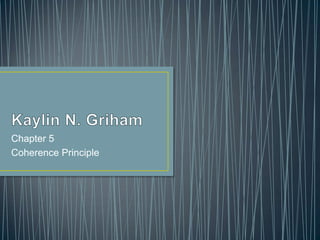Recommended
Recommended
More Related Content
Similar to K griham chapter 5
Similar to K griham chapter 5 (20)
Educational philosophy - Contribution of Education to National Development 

Educational philosophy - Contribution of Education to National Development
Psychological Foundations of Curriculum-Dr. D (EDITED).ppt

Psychological Foundations of Curriculum-Dr. D (EDITED).ppt
METHODS OF TEACHING: LECTURE METHOD AND STORY TELLING METHOD

METHODS OF TEACHING: LECTURE METHOD AND STORY TELLING METHOD
Instructional Materials by Mr. Jay Windel A. Calaluan

Instructional Materials by Mr. Jay Windel A. Calaluan
K griham chapter 5
- 2. • People learn better when interesting, but relevant details are excluded rather than included in the instructional materials. • People learn better when interesting, but irrelevant sounds and music are excluded from the instructional materials. • Extraneous words, pictures, and sounds should be excluded. • Example a presentation on the water cycle would not need graphics that relates to the muscular system.
- 3. • Seductive Details are used to add interesting, but irrelevant material to a passage in order to spice it up and adds interest for the reader. • The reader determines that the seductive details are entertaining and interesting. • The presence of seductive details may direct the learner’s attention away from the relevant material. • According to the cognitive theory of multimedia learning, adding seductive details will result in poorer performance on tests of transfer of knowledge.
- 4. • Arousal Theory • the idea that students learn better when they are emotionally aroused by the material. • According to the arousal theory, adding interesting but irrelevant material catches the reader’s attention so that they pay more attention and learn more overall. • In the case of adding interesting words and pictures, prior research shows that less is more. Less material can provide greater comprehension of presented material. • Students with low working memory capacity will spend more time focused on the graphics than on students with high working memory
- 5. • Based on the arousal theory • According to the theory, this addition makes the instructional materials more enjoyable for the learner, which raises the learner’s level of emotional arousal. • The cognitive theory of multimedia learning predicts a coherence effect in which adding interesting materials, such as music and sounds, hurts student learning.

